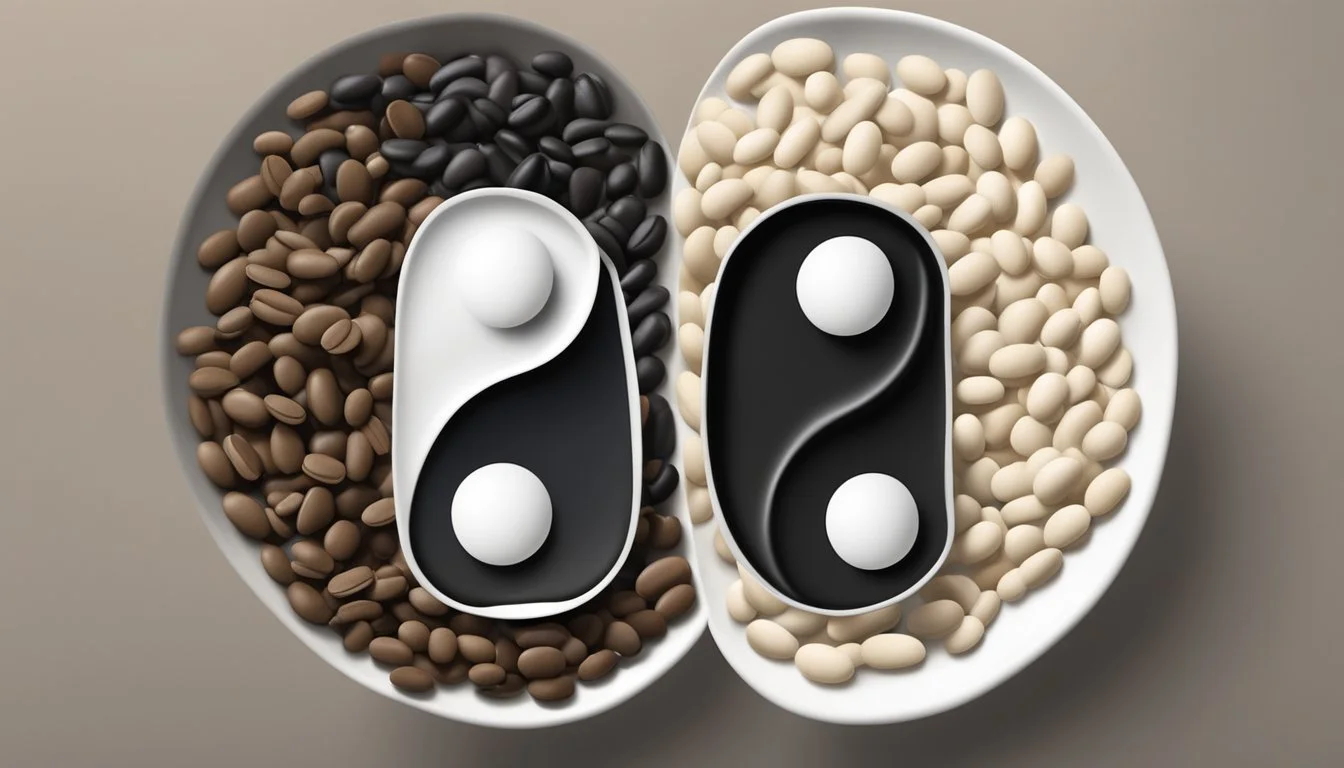Yin Yang Beans Substitutes
Best Alternatives for Your Recipes
Finding a suitable substitute for yin yang beans, also known as calypso beans, is essential for maintaining the desired flavor and appearance in recipes. These striking black-and-white beans belong to the Phaseolus vulgaris family and offer a distinctive look that's hard to match. One of the best substitutes for yin yang beans is a combination of black beans and white beans, adjusting the cooking time as needed.
Another excellent replacement option is cannellini beans, which can match the texture and cooking requirements of calypso beans. Additionally, black beans alone can serve as a straightforward substitute if you do not mind altering the visual appeal of your dish.
When preparing calypso beans or their substitutes, using plenty of water keeps them from losing their unique coloring. Whether you are aiming to preserve the aesthetic of yin yang beans or simply looking to maintain a similar taste and texture, these options can help you achieve satisfying culinary results.
Understanding Yin Yang Beans
Yin Yang beans, also known as Calypso beans, are a variety of Phaseolus vulgaris. They are characterized by their distinctive black and white appearance and are renowned for their nutritional benefits and smooth texture.
Origins and Characteristics
Yin Yang beans grow on bush-type bean plants and typically mature within 70 to 90 days from seed. Each pod usually contains 4 to 5 beans. The beans are notable for their black and white coloration, resembling the yin and yang symbol, which contributes to their name. When cooked, these beans double in size and maintain a smooth texture. They are not only visually appealing but also versatile in culinary applications, making them a popular choice in various cuisines.
Nutritional Profile
Yin Yang beans are rich in several important nutrients. They are an excellent source of dietary fiber and protein, which are essential for digestive health and muscle maintenance, respectively. Additionally, they contain iron, an important mineral for blood health, and provide a good energy source with their moderate calorie content.
A typical serving of Yin Yang beans includes:
Calories: Moderate, providing a good energy source
Protein: High, supporting muscle repair and growth
Fiber: Substantial, aiding in digestion
Iron: Beneficial for maintaining healthy blood levels
They are low in fat, making them a suitable option for a balanced diet. These beans play a role in promoting overall health due to their nutrient-dense profile.
Culinary Use Of Yin Yang Beans
Yin Yang Beans, also known as Calypso Beans, are valued both for their striking appearance and their culinary versatility. They can be prepared in various ways and fit seamlessly into numerous recipes, making them a favorite for everything from soups to salads.
Preparing Yin Yang Beans
To prepare Yin Yang Beans, begin by soaking the dried beans in water for at least 8 hours or overnight. This step helps to soften the beans and reduce cooking time. After soaking, drain and rinse them thoroughly.
Place the beans in a pot with fresh water, ensuring the water level is at least two inches above the beans. Add salt to taste, and optionally, garlic and ginger for extra flavor. Bring the pot to a boil, then reduce to a simmer. Cook for about 1.5 to 2 hours or until tender.
Recipe Ideas
Yin Yang Beans are versatile and can be included in a variety of dishes. For a hearty stew, combine cooked Yin Yang Beans with tomatoes, spices, and vegetables.
In salads, they offer a beautiful contrast and a nutty flavor; simply toss with olive oil, lemon juice, and your choice of greens. They also make an excellent addition to soups, providing texture and protein. For a simple stir-fry, sauté the beans with garlic, ginger, and a mix of colorful vegetables.
Pairings And Seasonings
Yin Yang Beans can be paired with diverse ingredients to enhance their flavor. For a vegan side dish, mix them with roasted vegetables and a dash of olive oil.
They work well with spicy seasonings like cumin, paprika, and chipotle, or more subtle ones like rosemary and thyme. Adding garlic and ginger during cooking can elevate their taste. Finally, a touch of cream can be stirred in at the end of cooking to create a richer, more indulgent dish.
Substitutes For Yin Yang Beans
Finding the right substitute for Yin Yang beans requires careful consideration of taste, texture, and cooking time. The substitutes listed below are readily available and can be used in various recipes.
Choosing The Right Substitute
When searching for a suitable replacement, it is essential to match the texture and flavor profile of Yin Yang beans as closely as possible. Black beans and kidney beans are excellent options due to their similar size and creamy texture. It's also beneficial to consider the cooking time. For instance, cannellini beans and chickpeas may require similar or slightly extended cooking times, making them convenient substitutes. Seasonal availability can also influence your choice. Some beans, such as black calypso beans and orca beans, might be less common in certain regions, impacting their regular use.
Common Substitutes
Here are some common substitutes:
Black Beans: Black beans are widely available and mimic the flavor and texture of Yin Yang beans. They cook to a soft consistency, making them a great alternative.
Kidney Beans: These beans are another good option due to their similar size and texture. Hybrid varieties may offer subtle differences in flavor and physical properties.
Cannellini Beans: Known for their creamy texture, cannellini beans serve as excellent substitutes. They blend well in soups and stews, providing a similar mouthfeel.
Chickpeas: Though slightly different in taste, chickpeas offer a firm texture that works well in salads and casseroles. Adjust cooking times accordingly.
Green Beans: For fresh dishes, like salads and stir-fries, green beans can provide a crunchy contrast, though they differ significantly in texture.
These substitutes ensure you can still enjoy dishes that call for Yin Yang beans, even when they are not readily available.
Additional Ingredients And Sides
When preparing Yin Yang beans, choosing the right complementary ingredients and side dishes can elevate the meal, enhancing both flavor and nutrition.
Complementary Ingredients
To enhance Yin Yang beans' flavor and texture, tofu can be an excellent addition. Tofu's mild flavor allows the beans' unique taste to shine while adding protein.
Vegetables like bell peppers, tomatoes, and carrots provide color and essential nutrients.
Nuts and seeds like almonds, sunflower seeds, or pumpkin seeds bring a crunch contrast to the soft beans.
Integrating spices such as cumin, coriander, and mild chili powder adds layers of flavor without overpowering the beans. Using wild rice or potatoes can also complement the dish, adding an earthy undertone.
Side Dishes Featuring Yin Yang Beans
Rice is an ideal side, particularly wild rice, which offers a nutty flavor that pairs well with the beans' mild taste.
Cornbread and other gluten-free bread options can be served to soak up the beans' rich broth without adding gluten.
For a balanced meal, consider a side of roasted vegetables—potatoes, carrots, and zucchini all work well.
Chili featuring Yin Yang beans can serve as a hearty side or main course, especially when served with a sprinkle of cheese and a dollop of sour cream.
This combination of ingredients and complementary side dishes ensures a well-rounded, flavorful dining experience.
Health Benefits and Considerations
Yin yang beans are not only versatile in cooking but also offer several health benefits and considerations important for a balanced diet.
Nutritional Advantages
Yin yang beans provide a rich source of fiber and protein, essential for maintaining a healthy digestive system and building muscle. They contain significant amounts of iron, which supports energy levels and overall health by aiding oxygen transport in the blood.
In addition, they are low-fat and heart-healthy, making them an excellent choice for those managing cholesterol and trying to reduce their risk of cardiovascular diseases. For individuals following gluten-free diets, these beans are a suitable option, as they are naturally gluten-free and help diversify dietary sources of nutrients.
Nutritional Table:
Nutrient Amount per 100g Protein 7g Fiber 6g Iron 2mg Fat 0.5g
In summary, the nutrient composition of yin yang beans makes them an advantageous addition to meals, supporting both general health and specific dietary goals.
Dietary Restrictions and Allergies
While yin yang beans are generally safe for consumption, individuals must consider allergies and dietary restrictions. Although rare, some people might be allergic to beans in general, and a reaction can include symptoms ranging from mild digestive issues to more severe responses.
These beans are naturally gluten-free, catering to individuals with gluten intolerances or celiac disease. However, when preparing yin yang beans, avoid cross-contamination with gluten-containing foods. It is also crucial to prepare them properly to avoid issues that might arise from lectins, which can cause abdominal discomfort if the beans are undercooked.
For those with specific dietary restrictions, consulting with a nutritionist or healthcare provider before integrating new foods into their diet is always recommended.






